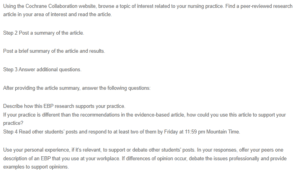Discussion – Evidence-Based Practice in the Workplace
Article Summary
The article selected is a review that aimed to find out if risk assessment tools can affect pressure ulcer development among patients at risk of getting pressure ulcers (Moore & Paltton D, 2019). The researchers used two relevant studies to conduct the review. The results of the study demonstrated the uncertainty regarding the use of risk assessment instruments as opposed to using clinical judgment when managing pressure ulcers. The studies showed no differences in the number of pressure ulcers that developed among the participants. Conclusively, the researchers ranked the evidence certainty as low to very low (Moore & Paltton D, 2019).
How EBP Research Supports the Practice
The above article suggests that risk assessment tools for the prevention of pressure ulcers do not reduce the occurrence of pressure ulcers. However, the article recommends that nurses should use clinical judgment to help prevent the occurrence and complications of pressure ulcers (Li et al., 2019). This evidence-based practice helps me in my practice by encouraging me to put more focus on and perfect the assessment techniques that will help identify the risks and early signs of pressure ulcers.
Relevance of the Recommendation to My Practice
In my practice in the emergency room, the use of my clinical judgment other than risk assessment tools would be key. Given the emergency room environment, time is a key resource that cannot be wasted; every intervention is important to prevent complications. Conducting risk assessment using tools is time-consuming and, at the same time, according to research, has no benefit in the prevention of pressure ulcers (Li et al., 2019). Therefore, this saves the health professionals in the emergency room time to concentrate on managing the patients.
References
Li, S., Cao, M., & Zhu, X. (2019). Evidence-based practice. Medicine, 98(39), e17209. https://doi.org/10.1097/md.0000000000017209
Moore, Z. E., & Patton, D. (2019). Risk assessment tools for the prevention of pressure ulcers. Cochrane Database of Systematic Reviews, 2019(1). https://doi.org/10.1002/14651858.cd006471.pub4
ORDER A PLAGIARISM-FREE PAPER HERE
We’ll write everything from scratch
Question
Using the Cochrane Collaboration website, browse a topic of interest related to your nursing practice. Find a peer-reviewed research article in your area of interest and read the article.

Discussion – Evidence-Based Practice in the Workplace
Step 2 Post a summary of the article.
Post a brief summary of the article and results.
Step 3 Answer additional questions.
After providing the article summary, answer the following questions:
Describe how this EBP research supports your practice.
If your practice is different than the recommendations in the evidence-based article, how could you use this article to support your practice?
Step 4 Read other students’ posts and respond to at least two of them by Friday at 11:59 pm Mountain Time.
Use your personal experience, if it’s relevant, to support or debate other students’ posts. In your responses, offer your peers one description of an EBP that you use at your workplace. If differences of opinion occur, debate the issues professionally and provide examples to support opinions.

